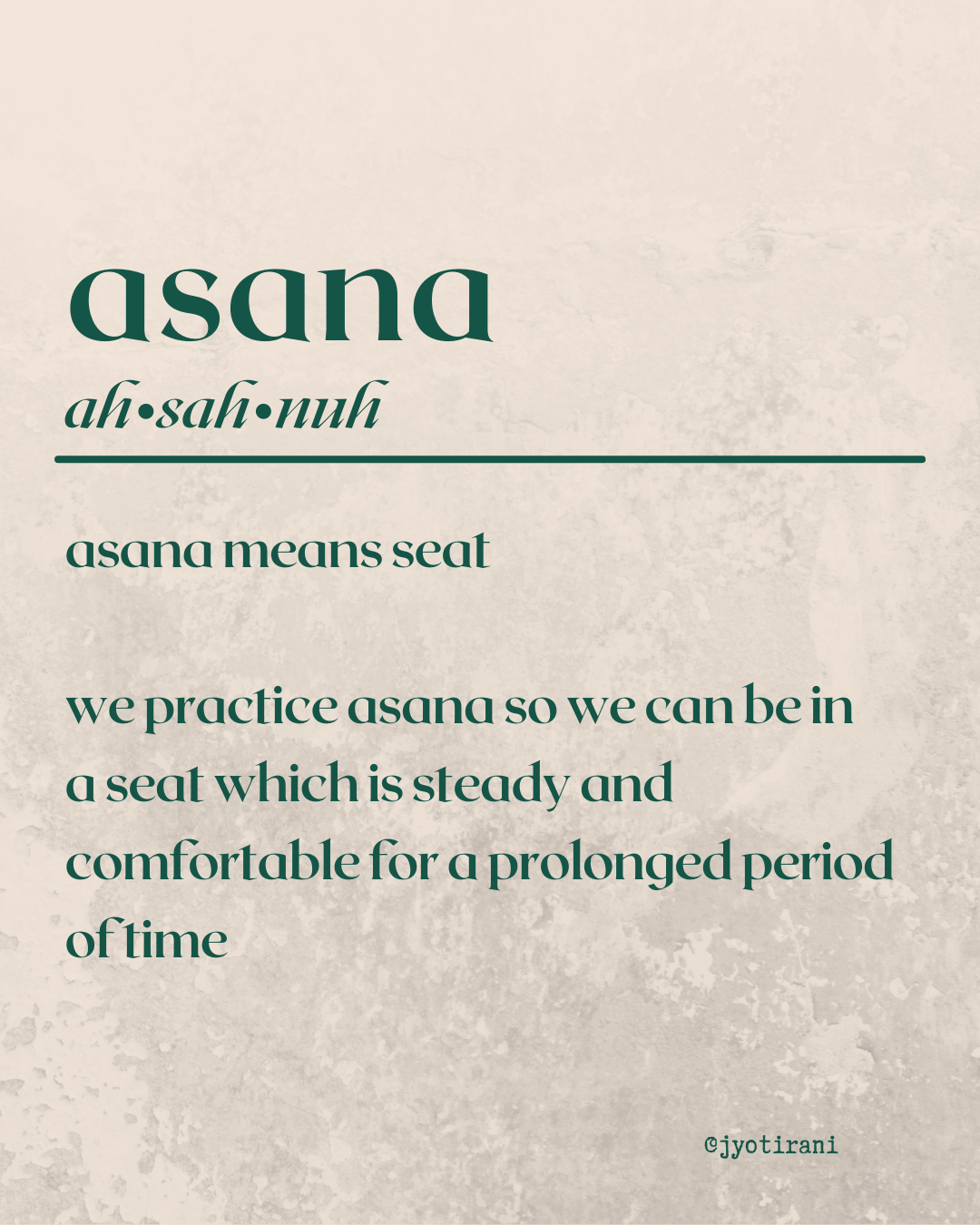Why Do We Practice Asanas?
Ahh, asana (ah-sah-nuh). This is a big one to explore so get settled in.
Be honest. When you hear the word yoga what do you think of? What images does it conjure up for you?
I would bet good money that it's someone (probably a white, thin, non-disabled woman but that’s a whole other blog post which you can find here) doing poses on a yoga mat. Am I right?
When I hear the word yoga I immediately think of the physical postures too, despite knowing that yoga is much more than this. Despite practicing the depth and breadth of yoga in my own practice and teaching this to my students. Despite talking about this on my podcast (Decolonizing Wellness: The Podcast) and being in a constant state of learning. Yet this is the lens through which yoga is sold to us in the West so it makes sense that to most of us, yoga = doing poses on a mat.
WHAT DOES ASANA MEAN?
Let’s take it back for a moment. In this series of blog posts, we are exploring the eight limbs of yoga as outlined in the Yoga Sutras by Patanjali. In this text, Patanjali explains each limb in varying depths. He mentions asana, the third limb, in one sentence, two words to be exact. Yep, that’s right. The vision we have when we think of yoga is just one sentence of the 196 sutras.
The sentence about asanas reads - ‘sthirasukham aasanam’ and translates to ‘a seat which is steady and comfortable’.
On its own, asana means seat. In the Yoga Sutras it is explained as a seat or posture which is steady and comfortable. Through our practice of the different asanas we strengthen the body and make it more flexible which allows us to sit comfortably in a seated position for a prolonged period of time. We don’t feel the body and this enables us to focus on the next five limbs, to be still and concentrate the mind and we are no longer distracted by aches, pains or other bodily sensations.
The purpose of asana is not to learn to do a handstand, headstand, crow pose or any other aesthetically pleasing posture so we can post it on social media. There’s nothing wrong with wanting to be able to achieve these asanas or being able to do them, of course not. The issue arises when we make that the sole focus. That is when we lose sight of what yoga is.
Ask yourself:
Why do you practice asanas?
Do you practice asana as a form of exercise?
Do you practise asana to be strong and flexible?
Is there a deeper reason that you practise asana?
What are the benefits of asana?
Within the asana family there are different groups of asanas you can do, and each has their own benefits.
Relaxation asanas, such as shavasana, relax the spine and related structures. We spend much of our time carrying tension so the importance of including these asanas as part of your practice cannot be overstated
Standing asanas allow the back, shoulders and leg muscles to be strengthened and stretched. They’re especially beneficial for those who spend a lot of time sitting down or experience low level back pain. They improve posture, balance, muscular coordination and lung capacity.
Backward bending asanas stretch the abdominal muscles and strengthen the muscles that control the spine. During backbends the body is facing the world so they are stimulating and extroverted postures that expand the chest and encourage inhalation.
Forward bending asanas use gravity to help release tension and pain. They are introverted postures since the chest is compressed, encouraging exhalation and inducing relaxation. These asanas loosen the back, improve circulation around the spine and massage the abdominal organs. It is important to bend from the waist, not the hips when performing forward bends.
Spinal twisting asanas stimulate the spinal nerves and improve spinal flexibility. They also encourage pranic flow is the navel area which nourishes the digestive organs - stomach, kidneys, pancreas, small intestines, liver, gall bladder - and relieves associated disorders.
Balancing asanas improve muscle coordination and posture. They also ease stress and anxiety since the focus needed to perform these asanas develops concentration and balance at the mental, physical and emotional level
Inverted asanas encourage blood to flow to the brain, nourishing neurons and flushing out toxins. Since our perspective changes in these asanas, they can feel refreshing and revitalizing. They can also increase mental power, concentration and self confidence.
As you can see, each asana has many benefits ~ physical, mental and emotional ~ for why they are performed. However this knowledge is lost in a typical sixty minute yoga class. That’s why I ensure I explain the benefits of different asanas during my classes ~ this allows my students gain a deeper understand and begin to tailor their practice.
When you go to your next yoga class, I encourage you to ask your teacher what the benefits of specific asanas are. Why are you doing them? Do they know? Or begin to research it for yourself. It is with this knowledge that you can start to take your asana practice into your own hands. You can start to adapt your practice to what your body needs on any given day.
I would love to hear how you get on - please do reach out on Instagram or by email.
With love and gratitude,
Jyoti x
(pronounced Jyoh-thee)
Article written for Ekotex Yoga ~ visit www.ekotexyoga.com to see more and save 10% with my code 'JYOTIRANI'

